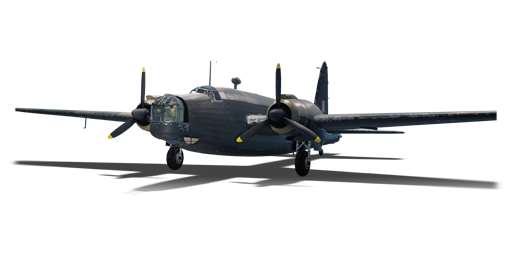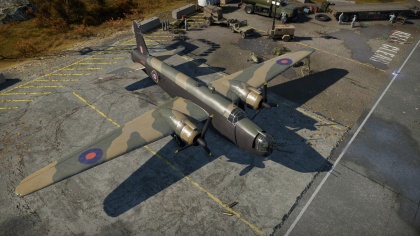Wellington Mk X
Contents
| This page is about the British bomber Wellington Mk X. For other uses, see Wellington (Family). |
Description
The Wellington Mk X is a rank British bomber
with a battle rating of (AB), (RB), and (SB). This aircraft has been in the game since the start of the Open Beta Test prior to Update 1.27.
General info
Flight Performance
Describe how the aircraft behaves in the air. Speed, manoeuvrability, acceleration and allowable loads - these are the most important characteristics of the vehicle.
| Characteristics | |||||||
|---|---|---|---|---|---|---|---|
| Stock | |||||||
| Max Speed (km/h at 4,053 m) |
Max altitude (meters) |
Turn time (seconds) |
Rate of climb (meters/second) |
Take-off run (meters) | |||
| AB | RB | AB | RB | AB | RB | ||
| 392 | 377 | 36.3 | 37.5 | 3.2 | 3.2 | 650 | |
| Upgraded | |||||||
| Max Speed (km/h at 4,053 m) |
Max altitude (meters) |
Turn time (seconds) |
Rate of climb (meters/second) |
Take-off run (meters) | |||
| AB | RB | AB | RB | AB | RB | ||
| ? | ? | ??.? | ??.? | ??.? | ??.? | 650 | |
Details
| Features | ||||
|---|---|---|---|---|
| Combat flaps | Take-off flaps | Landing flaps | Air brakes | Arrestor gear |
| ✓ | ✓ | ✓ | X | X |
| Limits | ||||
|---|---|---|---|---|
| Wing-break speed (km/h) |
Gear limit (km/h) |
Combat flaps (km/h) |
Max Static G | |
| + | - | |||
| 355 | ~5 | ~3 | ||
| Optimal velocities | |||
|---|---|---|---|
| Ailerons (km/h) |
Rudder (km/h) |
Elevators (km/h) |
Radiator (km/h) |
| < 275 | < 275 | < 310 | > 320 |
| Compressor (RB/SB) | ||
|---|---|---|
| Setting 1 | ||
| Optimal altitude | 100% Engine power | WEP Engine power |
| 1,250 m | 1,420 hp | 1,662 hp |
| Setting 2 | ||
| Optimal altitude | 100% Engine power | WEP Engine power |
| 3,710 m | 1,315 hp | 1,539 hp |
Survivability and armour
- 9 mm Steel plate in the pilot's seat.
Armaments
Suspended armament
The Wellington Mk X can be outfitted with the following ordnance:
- 10 x 250 lb G.P. 250 lb Mk.IV bombs (2,500 lb total)
- 18 x 250 lb G.P. 250 lb Mk.IV bombs (4,500 lb total)
- 9 x 500 lb G.P. 500 lb Mk.IV bombs (4,500 lb total)
- 2 x 1,000 lb AN-M65A1 bombs + 6 x 250 lb G.P. 250 lb Mk.IV bombs (3,500 lb total)
- 2 х 18 inch Mark XII torpedoes
- 1 x 4,000 lb H.C. 4,000 lb Mk.II bomb (4,000 lb total)
Defensive armament
The Wellington Mk X is defended by:
- 2 x 7.7 mm Browning .303 machine guns, nose turret (1,200 rpg = 2,400 total)
- 4 x 7.7 mm Browning .303 machine guns, rear turret (2,000 rpg = 8,000 total)
- 1 x 7.7 mm Browning .303 machine gun, 2 x side turret (1,200 rpg)
Usage in battles
Tactics
In AB the winning tactic is to climb high and do base bombing with 500’s “from orbit”; it helps to have escorts.
In RB you start in the air so you have the advantage to trade altitude for airspeed and bomb ground targets and retreat before enemy fighters start to arrive, however, be close to friendlies so they can intercept chasers.
Counter-tactics
If you are attacking a Wellington, focus on its engines, they are relatively easy to set on fire. While you should not worry too much about the turrets, do not hang around either, as an attack from the rear is still dangerous as the rain of 7.7 mm may cause an engine fire. As usual, do not rely on luck to win engagements.
Manual Engine Control
| MEC elements | ||||||
|---|---|---|---|---|---|---|
| Mixer | Pitch | Radiator | Supercharger | Turbocharger | ||
| Oil | Water | Type | ||||
| Not controllable | Controllable Not auto controlled |
Not controllable Not auto controlled |
Controllable Not auto controlled |
Combined | Controllable 2 gears |
Not controllable |
Modules
| Tier | Flight performance | Survivability | Weaponry | ||
|---|---|---|---|---|---|
| I | Fuselage repair | Radiator | Protective vest | Turret 7 mm | TC mk.I |
| II | Compressor | Airframe | LBC mk.I | ||
| III | Wings repair | Engine | New 7 mm MGs (turret) | SBC mk.I | |
| IV | Engine injection | Cover | MBC mk.I | ||
The default bomb load is a meagre 10 x 250 lb (117 kg) so upgrading to 18 x 250 or 9 x 500 "pounders" (500 lb (226 kg)) should be task number one. In order: unlock the Turret 7 mm ammo first, then the TC mk.I (torpedo) rack, and then the LBC mk.I. Unlocking the 7 mm ammo gives access to the "Universal" AP-I belt as one works up to the bomb racks for 18 x 250 lb or 9 x 500 lb. After that, you can pursue your choice of upgrades.
Upgrades to the turret should also be considered. The different belts do not have a considerable effect, but the upgraded turrets allow for a longer fire at a greater rate, which is very important for the small rifle calibre machine guns.
However, speed and climb rate is also a necessity and the unlocks help the sluggish Wellington a lot. The decision should depend on the pilot's flying style. When rushing in, better armament will help in the retreat, but better performance will aid in returning to friendly zones quickly.
The sneaky approach, on the other hand, relies less on speed, but on surviving the random combat encounters. Turret upgrades are the way to go for this playstyle.
Pros and cons
Pros:
- Versatile payload options
- Airframe itself is very durable
- Usable payload stock, and fairly average once upgraded
- Extreme horizontal firing arc on front and rear turret of just over 180 degrees
- Good gunner ammunition supply
Cons:
- Hopelessly outclassed by enemy fighters of similar rank
- Defensive turrets are easy to take out
- Defensive armament is poor
- Slow speed
- Bad climb rate, largely due to the combination of the heavy airframe with only average engines
- Lack of armour makes engines, crew, fuel tanks, etc noticeably vulnerable
- Control stiffening becomes a serious issue at airspeeds over 450 km/h
History
Performance-wise the Wellington was not notably remarkable, its strength lay on the inside. Devised by one of the greatest innovative thinkers in history, Sir Barnes Neville Wallis devised a geodesic structure resulting in an exceptionally strong airframe. Together with Reginald Kirshaw "Rex" Pierson, they designed their record-making "Vickers Wellesley", paving the way for the "Wellington" and larger "Warwick".
With high aspect ratio wings and a spacious fuselage, it proved capable of handling a myriad of missions including early airborne radar and robust enough to absorb severe damage and fly home. Although the bomb bay configuration limited bomb size, its payload was slightly more than the Heinkel He 111 H-3 and with greater range. It is also one of the first aircraft to have a powered turret in the extreme tail with a very wide arc; however, it was still inadequate to defend itself against attacking fighters and early models lacked self-sealing fuel tanks. Still, this aircraft was admired by crews and affectionately called “Wimpy” after Popeye's hamburger loving friend and sidekick whose full name is J. Wellington Wimpy.
Over 11,000 made, it equipped many RAF squadrons including those comprised of foreign crews like the Polish (4 squadrons), New Zealand (No. 75), and Czech (No. 311), one of which was captured by the Germans who used it for intelligence and training. "Viking", a passenger transport variant, became the world's first pure jet transport prototype aircraft in 1948.
In-game description
"A twin-engine medium bomber, the Wellington Mk.X became the last production variant used by RAF Bomber Command. Its design was based on the Mk.III's airframe, and it featured similar armament and equipment. The main difference was a new 1,675 hp Bristol Hercules Mk.VI (though some planes featured the Hercules Mk.XVI) fourteen-cylinder double-row air-cooled engine. There was also a difference less noticeable but no less important than the replaced engine: the switch to newly developed light alloys with a better strength-to-specific gravity ratio. Using this alloy in the aircraft's structure allowed a higher take-off weight while preserving the Mk.III's flight characteristics. Full-scale production of the Mk.X (Type 448) model started in the autumn of 1942 and it became the most numerous variant of the Wellington, with a combined total of 3,803 aircraft built.
After initial heavy losses in daylight bombing raids at the beginning of the war, the Wellington saw more success after changing role to night bombing. The aircraft also began serving in North Africa in September 1940 and in the Far East in April 1942. By 1942-43, the Wellington became the RAF Bomber Command's primary medium bomber; it was faster than the Armstrong Whitworth Whitley and it had a longer range than the Handley Page Hampden, even though its payload was just as great. In the first ""1,000 bomber raid"" on Cologne on May 30th 1942, 599 of the 1,043 aircraft were Wellingtons.
The Wellington bombers' last operational sortie with Bomber Command in Western Europe was on the night of October 8, 1943. The Wellington was succeeded by heavy four-engine aircraft such as the Short Stirling, the Handley Page Halifax, and the Avro Lancaster, as the RAF Bomber Command increased its pressure on Germany. However, variants of the Wellington Mk.X continued to serve with RAF Coastal Command for the remainder of the war; the Mks.XI through to XIV were all maritime versions of the Mk.X, fitted with ASV radar. And a variety of armaments.
Coastal Command Wellingtons were employed in protecting allied shipping in the South West Approaches from enemy submarines. Notable successes were scored by 172 Squadron, operating from RAF Chivenor, who were the first unit to attack a U-Boat at night using a combination of radar and a special carbon arc searchlight. October 1945 saw the construction of the last of 11,461 Wellingtons, and the aircraft was withdrawn from service in March 1953 after finishing its RAF career as a pilot and navigator trainer.
Media
Excellent additions to the article would be video guides, screenshots from the game, and photos.
See also
Links to the articles on the War Thunder Wiki that you think will be useful for the reader, for example:
- reference to the series of the aircraft;
- links to approximate analogues of other nations and research trees.
External links
Paste links to sources and external resources, such as:
- topic on the official game forum;
- encyclopedia page on the aircraft;
- other literature.
| Britain bombers | |
|---|---|
| Torpedo | Swordfish Mk I · Swordfish Mk II · ▄Avenger Mk II |
| Dive | V-156-B1 |
| Hydroplanes | ▄Catalina Mk IIIa · Sunderland Mk IIIa · Sunderland Mk V |
| Light | Blenheim Mk IV · Beaufort Mk VIII · ▄Hudson Mk V · Brigand B 1 |
| Based on A20 | ▄Havoc Mk I · ▄Boston Mk I · ▄DB-7 |
| Hampden | Hampden Mk I · Hampden TB Mk I |
| Wellington | Wellington Mk Ic · Wellington Mk Ic/L · Wellington Mk III · Wellington Mk X |
| Halifax | Halifax B Mk IIIa |
| Stirling | Stirling B Mk I · Stirling B Mk III |
| Lancaster | Lancaster B Mk I · Lancaster B Mk III |
| Lincoln | Lincoln B Mk II |
| Shackleton | Shackleton MR.Mk.2 |





